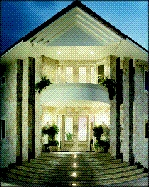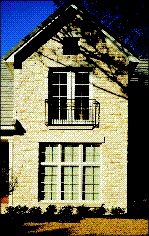Ownership Made Easy
The beauty of a concrete home is that it requires far less work on the part of the homeowner to keep it looking like new. What are the three most common causes of exterior wall maintenance? Termites, rotting, and paint peeling or fading. Concrete homes are rarely, if ever affected by termites or rot. As to paint, while some contemporary concrete homes have wood siding, most have a stucco or brick facade. Some use a concrete texture or other concrete products as finishes. None require painting.
 A concrete home requires far less work to keep it looking like new. All of this translates into a concrete home costing less to own than a wood-frame or wood veneer home.
A concrete home requires far less work to keep it looking like new. All of this translates into a concrete home costing less to own than a wood-frame or wood veneer home.
Standing Up To the Elements
Part of maintaining a home during its lifetime involves repair of damage from such elements of nature as rain, wind and termites. A concrete wall is more resistant to the wind and rain of hurricanes, tornadoes and other major windstorms. When Hurricane Andrew roared through South Florida, concrete homes protected families far better than their wood-frame counterparts. Homes built with concrete walls can also be designed to withstand the destructive forces of earthquakes.
Two of nature's threats to homes - termites and dry rot - are more subtle than hurricanes, tornadoes, and earthquakes. But they can be just as costly. While an infestation of termites can cause severe structural damage to a wood-frame house, the structural walls of a concrete home are safe from their destructive efforts. Dry rot is actually a disease, common to timber and caused by fungi. Dry rot does not affect concrete and is therefore not a worry for the owners of a concrete home.
Timeless Designs
Whether a Victorian gingerbread home or a Colonial mansion, concrete homes are quiet, easy-to-maintain and safe from fire, hurricanes, termites and wood rot. Concrete also can be used to create classic, low maintenance floors with patterns similar to classic stonework but with a look all their own.
Fire Prevention
Concrete homes are more resistant to fire than wood-frame homes. This gives your family a better chance of avoiding injury due to fire. Even if a concrete home does catch on fire, the damage does not seriously affect the structure of the walls, making repair a simpler task.
Today's Concrete Home
The concrete home building systems available today have evolved to the point where you can design your home to require a minimum of maintenance while providing a maximum of protection...and it will still look new for years after it is built.
 A concrete home requires far less work to keep it looking like new.
A concrete home requires far less work to keep it looking like new.
That's The Beauty of Today's Concrete
There's more than one way to build your concrete home - insulating concrete forms, concrete masonry, aerated concrete, tilt-up concrete, or precast concrete to name a few. With volatile wood prices, logging's high environmental price tag, and a growing shortage of high quality lumber, concrete offers a variety of products and construction techniques to provide cost effective, quality alternatives to wood-frame home construction.
All of these systems share the same basic virtues of concrete - beauty, strength, durability, low maintenance, energy efficiency, interior environmental quality, environmental friendliness, and peace and quiet. Which concrete building technique is right for you depends on the labor force and predominant building practices in your area. Whatever your choice, you can rest assured that your beautiful concrete home is built to last.